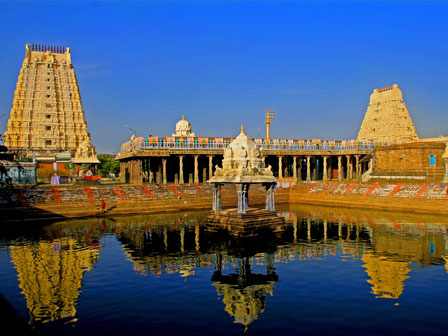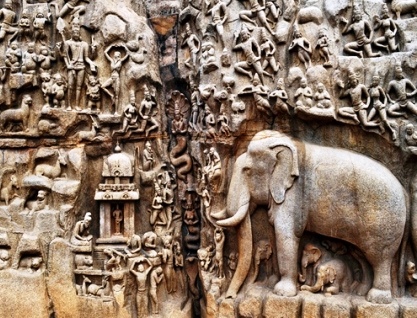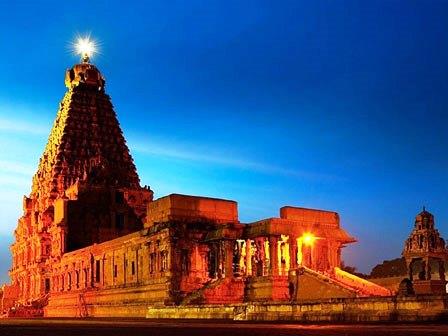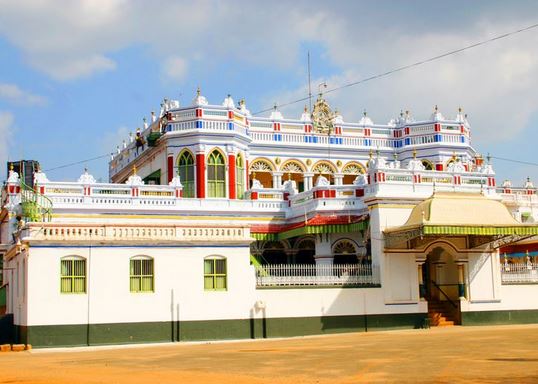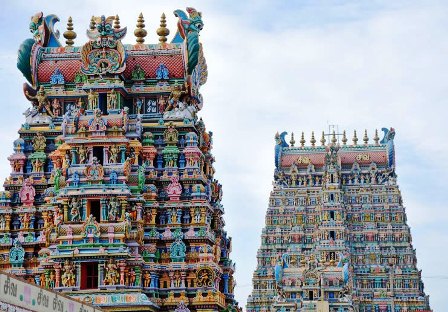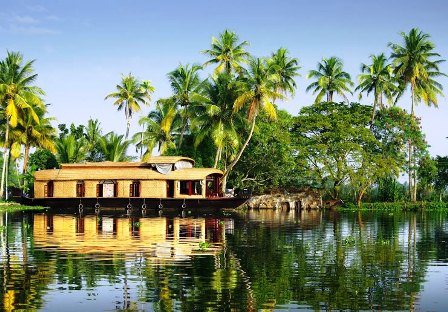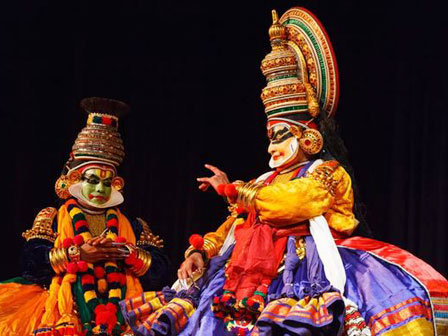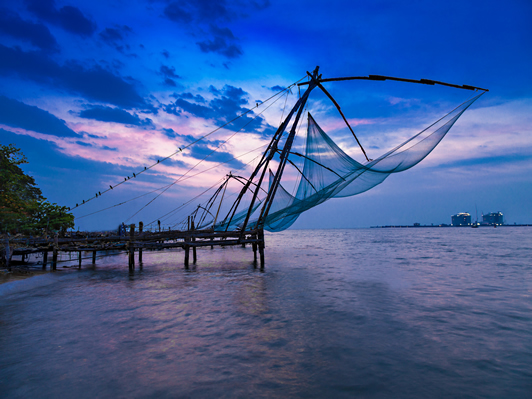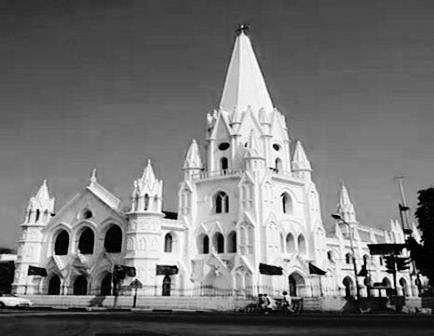
Explore South India with TravelAstu - 22 Days
Chennai - Mahabalipuram - Tanjore - Trichy - Madurai - Periyar - Backwaters - Varkala - Cochin -Coonoor- Ooty - Mysore - Bangalore
Experience the magnificent living temples from Kanchipuram up into the hills of the Western Ghats and on to the pristine backwaters of Kerala. This is a journey with a authentic taste of of South India & the chance to experience the culture and the natural marvels of this magical land.
Day 1: Chennai
You will be received by TravelAstu representative at international airport in Chennai.
Transfer to your hotel.
Chennai is the capital of the Indian state of Tamil Nadu. Located on the Coromandel Coast off the Bay of Bengal, it is one of the biggest cultural, economic and educational centres in South India.
Half day sightseeing of Kapleeshwarar temple of lord Shiva built in dravidian style and Fort St George.
Overnight in Chennai.
Day 2: Chennai – Kanchipuram – Mahabalipuram
By road 2 hours
After early breakfast proceed by company car to Mahabalipuram visiting Kanchipuram en route.
In Kanchipuram sightseeing of Ekambreswar temple and Shankrachaya Math.
Reach Mahabalipuram and transfer to hotel.
Mahabalipuram was the earlier name of Mamallapuram because the demon king Mahabali was killed by Lord Vishnu. Mahabalipuram lies on the Coromandel Coast which faces the Bay of Bengal. This is an elegant place to watch which a well-established sea port was during the 7th and 10th centuries of the Pallava dynasty.
Overnight will be spent in Mahabalipuram.
Day 3: Mahabalipuram
Breakfast will be at the hotel.
Enjoy visit to the following places:
CAVES: There are nine rock-cut temples. The Mahishasuramardhini cave, depicting the goddess fighting a demon on one side and Lord Vishnu's cosmic sleep on the other, is a particularly remarkable one.
KRISHNA MANDAPAM: A bas-relief, notable for its realistic representation. The panel relates to one of the stories of Lord Krishna.
ARJUNA’S PENANCE: This is the world's largest bas relief measuring 27m X 9m. This huge whale-backed rock contains figures of gods, demigods, men, beasts, birds and almost all of the entire creation. And, this is easily the pride of Mamallapuram.
THE FIVE RATHAS: There are the five monolithic temples, each created in a different style. They are also known as the Pancha Pandava Rathas – and four out of the five Rathas are supposed to have been carved out of a single rock.
THE SHORE TEMPLE: This is one of the oldest temples. Unique about this temple is the fact that it houses shrines for both Lord Shiva and Lord Vishnu. This belongs to the early 8th century AD and it is a classic example of the first phase of structural temples constructed in pure Dravidian style.
Overnight will be at Mahabalipuram.
Day 4: Mahabalipuram - Trichy
By Road 5 hours
Early breakfast in hotel.
Depart for Trichy by road. A drive of around 5 hours through the rich agricultural lands of Tamil Nadu.
Reach and transfer to hotel.
Situated on the banks of river Kaveri, Trichurapalli, the fourth largest city in the state was a citadel of the early Cholas, which later fell to the Pallavas. Trichy came to be occupied in turn by the Nayaka of Madurai, the Marathas, the Nawabs of Carnatic, the French and finally the British. But it was under Nayakas of Madurai that Trichy flourished and prospered in tit’s own right and grew to be the city that is today. Trichy is fine blend of tradition and modernity built round the rock fort Apart from the fort there are several Churches, Colleges and Missions dating back to the 1760s. With Excellent infrastructural facilities Trichy will serve as a good base to explore the South of Tamilnadu.
Enjoy the sightseeing of Trichy.
Visit the ancient temples dedicated to Lord Ganapathy, 434 steps cut out into the rock side and interspersed with shrines, lead to the temple. Visit SRIRANGAM, a massive temple dedicated to Lord Vishnu sprawled on an Island in CAUVERY RIVER which contains within its walls a Bazaar (TRADITIONAL MARKET OF INDIA) as well. Gaze up at the twenty-one magnificent towers of the temple surrounded by seven walls.
Overnight will be at Trichy.
Day 5: Trichy - Tanjore
By road 2 hours
After breakfast drive to Tanjore.
Tanjore or Tanjavur as it was earlier called, was the capital of the chola empire from the 10th century to the 14th century A.D. later is become part of the vijaynagar kingdom, then passed into the hands of the Marathas and later still went to the British. For ages it has been the chief political. Literary and religious centre of the South. The celebrated temple Brihadeshra built by the Chola King during the 11th century is its major attraction. The Saraswati Mahal library, dating back from the time of the Marathas, containing a rare collection of books and manuscripts on paper and palm leaves. The home of carnatic music, musical instruments, dance, and the traditional Handicrafts. Tanjore is famous for the lord Brahadiswara temple {lord Siva}. Tanjore is the rice bowl of India. It is well contacted by air, train, and road transport.
Brihadeshwara Temple or Big temple – The Brihadeeswara Temple is the main attraction of Tanjore. The massive temple built by Raja Raja Chola reflects the Cholas’ contribution to the development of arts in this area. It is also regarded as the Chola dynasty's finest contribution to the Dravidian temple architecture. Listed as a World Heritage site, the temple is visited by a large number of people for the regular worship here. The temple is characterised by its unique structure. Unlike the usual South Indian temples, the Brihadeeswara temple has a soaring vimana and a stunted gopuram. It was constructed from a single piece of granite weighing an estimated 80 tonnes and the dome was hauled into place along a 4 km earthwork ramp in a manner similar to the Egyptian pyramids. A huge Nandi, about 6 m long and 3.7 m high, faces the inner sanctum. The statue of Nandi was created from a single rock piece and weighs 25 tonnes. It is in fact one of the largest statues of Nandi bulls in India. The temple also has a spacious ground, number of pillared halls, shrines and 250 lingams.
The Palace – The Palace of Tanjore also makes an important tourist destination. The royal Palace near the massive Brihadeshwara temple is characterized by its vast corridors, large halls, shady courtyards and observation and arsenal towers. Built by the Nayak in the mid-16th century, the Palace was com-pleted by the Marathas. The Durbar Hall of the palace still retains the grandeur of the bygone era. The palace also functions as a Royal Museum housing a diverse collection of royal remnants, compilations of the early 19th century, the king’s slippers, head dresses and hunting tools.
Saraswathi Mahal library – Located just by the side of the art gallery, the Saraswati Mahal Library has a huge collection of about 30,000 palm leaf and paper manuscripts in Indian and European languages. It also has some Tamil works including treatises on medicine, and commentaries on works from the San-gam period. It was built during 1700 AD. You can visit the nearby museum that houses some interesting exhibits like the entire range of the Ramayana written on palm leaf. Checkout the time and entry fee before you visit the Saraswati Mahal library
The Art Gallery and the Saraboji palace – The Art Gallery is another must see of Tanjore. It has a rich collection of 250 Chola Bronze statues and 150 stone statues dating from the 9th to 12th century. These statues belong to the many groups namely the Bhairava, Umasahita Shiva, Kali and the Rama Lakshmana. You can have a look at all these wonderful collections by paying a nominal entry fee. large and excellent collection of chola bronzes, granite pieces. look for bhairavas, umasahista Siva, kali, somaskandha and the Ramalakshmana group.
Overnight stay will be at Tanjore.
Day 6: Tanjore - Chettinad
By Road 2 hours
Breakfast at hotel.
Departure by road to Chettinad.
Transfer to hotel.
Chettinad is something of a world apart and a truly unique destination. The merchants and traders (the Chettiars) who hailed from this region amassed significant fortunes throughout the 19th and early 20th centuries from their roles as bankers and business go-betweens for many of the empires from both East and West which traded in south India during that time. Many of them poured their fortunes into building remarkable homes- some over 40000sq ft and with dozens of rooms and many courtyards. You’ll be able to tour Chettinad Palace, the biggest of them all, and to stay in another, fully restored mansion overnight. Chettinad is also famous for its unique cuisine which known for complex flavours and innovative use of ingredients.
Visit the local markets and temples, observe the local craft of tile-making, ride around the village by bullock cart, and explore the district headquarters of Karaikudi.
Overnight in Chettinad.
Day 7: Chettinad - Madurai
By road 2 hours
After breakfast proceed to Madurai.
One of South India's great temple towns, Madurai is synonymous with the celebrated Meenakshi Temple. Situated on the banks of river Vaigai, Madurai has a rich cultural heritage passed on from the great Tamil era more than 2500 years old. Madurai was an important cultural and commercial centre even as early as 550 AD. Madurai was the Capital city for the great Pandyas kings. Tamil & Greek documents record the existence of Madurai from the 4th Century BC. The city was known to the Greeks through Magathenes who was their ambassador to the court of Chandraguptha Mauriya. This city was popular in trade especially in spices. It was also the site the Sangam the academy of the Tamil Poets. And Madurai is the centre of all the cities and Madurai is famous for the cotton Sungudi Saris.
Madurai's Main attraction is the Famous Sri Meenakshi Amman temple a riotously baroque example of Dravidian architecture with Gopurams carved from top to bottom in a breathtaking profusion of multi-colored images of Gods. Sri Meenakshi Amman temple dates back to 2000 Years back and designed in 1560 by Vishwanatha Nayaka and built during the reign of Tirumalai Nayaka. The Temple occupies an area of six hectares. There are 12 temple towers (Gopurams). The outer towers are the landmarks of Madurai. The enormous temple complex is dedicated to Shiva, known here as Sundareshvara and his consort Parvati or Meenakshi. Kulasekara Pandyas, but the entire credit built the original temple for making the temple as splendid as it is today goes to the Nayaks. The Nayaks ruled Madurai from the 16th to the 18th century and left a majestic imprint of their rule in the Meenakshi - Sundareswarar Temple. The temple complex is within a high-walled enclosure, at the core of which is the two sanctums for Meenakshi and Sundareswarar, surrounded by a number of smaller shrines and grand pillared halls. The impressive GOPURAMS (towers) rise from solid granite bases, and are covered with stucco figures of deities, mythical animals and monsters painted in vivid colors.
Overnight will be at Madurai.
Day 8: Madurai
After breakfast enjoy the sightseeing of Madurai.
The ancient city of Madurai, some 2600 years old is laid out in the banks of river Vaigai as a lotus flower with the Meenakshi temple in the centre. After lunch city tour visiting - Meenak-shi temple, King Tirumala's Palace, Great Tank and Gandhi museum.
Sri Meenakshi Amman temple: dated back to 2000 Years back and designed in 1560 by Vishwanatha Nayaka and built during the reign of Tirumalai Nayaka. The Temple occupies an area of six hectares. There are 12 temple towers (Gopurams). The outer towers are the landmarks of Madurai. They are:
Vandiyur Mariamman Teppakulam: Vandiyur Mariamman Teppakulam is a huge temple tank about 5 km east of the Meenakshi temple. The mandapam in the centre has an idol of Vigneshwara (Vinayaka). It is said to have been found when the earth was being dug out from here to build the Thirumalai Nayakkar Mahal. So, the place attained sanctity and was converted into a teppakulam (tank). This enormous temple tank is fed by water brought from the Vagai through an ingenious system of underground Channels. King Thirumalai Nayak born in 'Poosa' Star. so in commemorating the birth of the king “ Float Festival” is conducted in Tamil Month 'Thai' (Jan/Feb) in the tank in a colourful way, which attracts thousands of tourists.
Gandhi Museum: The Gandhi Memorial Museum is one of the distinct places to be visited in Madurai. This Museum is one of the rare living memorial of "The Father of India". The Muse-um is set in relaxing grounds and has a clear historical account of India’s struggle for Inde-pendence.
Thirumalai Nayak Palace: This Palace was built in 1636 by King Thirumalai Nayak with the help of an Italian Architect. The building we see today was the main Palace where the King lived. The original Palace Complex was four times bigger than the present structure. This palace consisted mainly of two parts, namely Swargavilasa and Rangavilasa. In these two parts, there are royal residence, theatre, shrine, apartments, armoury, palanquin place, royal bandstand, quarters, pond and garden. King Thirumalai Nayak celebrated festivals like Sceptre festival, Navarathri, Chithirai festival, Masi festival and the Float festival. He con-ducted daily dance and music performances in the palace. This palace was destroyed by his grandson Chokkanatha Nayak and the valuables were transferred to other places. During the British rule, in 1822, Lord Napier made several renovation works. Then the palace was utilized to house some officials of the judiciary and district administration. After independ-ence, this palace was declared as a national monument and is now under the care of the Tamilnadu Archaeological Department.
Overnight will be at Madurai.
Day 9: Madurai - Periyar
By road 3-4 hours
Breakfast will be at hotel.
Four hour drive southwards over rolling hills and coffee plantations to the PERIYAR WILDLIFE SANCTUARY, one of the major wildlife reserves in India. Indian elephants, wild boars, lion-tailed monkeys, ibex, tigers, leopards and sloth bears are on the list. The park surrounds a large, many-fingered lake and a dawn or dusk foray on one of the boats will be a thrilling experience. It is from the lake rather than vehicles that the wildlife is viewed. The sanctuary is rich in bird life. Great hornbills, kites, darters, herons, egrets, owls and kingfishers are in abundance. Surrounding the reserve are many small spice plantations and we spend an absorbing afternoon searching for pepper, cardamom, turmeric, cloves, nutmeg, ginger, cinnamon and betel.
Visit spice plantations like cardamom, cinnamon, pepper, coffee, tea estates etc. on your way back to the hotel, you could stop at the local market and pick up some fragrant spices.
Later, visit Kumily market to buy the best spices available.
Overnight will be at Thekkady.
Day 10: Periyar - Varkala
By road 4 hours
Breakfast will be at hotel.
Time in the morning for a tour of a spice plantation, along with the opportunity to feed and bathe an elephant before heading down the Ghats to Varkala and the golden sands of the south Kerala coast. This is a long drive through some beautiful scenery - you will reach Varkala in the late afternoon.
Overnight in Varkala.
Day 11: Varakala
Breakfast in resort.
The pristine Varkala beach entices you with its myriad attractions to come and explore its tranquil sands.
Be awe-struck at the force of the sea waves as they crash against the rocky clusters near the Varkala beach; build sand castles and relax under a coconut palm on the beautiful Varkala beach as you spend a refreshing holiday in this part of Kerala.
Located at a distance of 41 kilometers from Thiruvananthapuram in Kerala, South India the Varkala beach is the perfect holiday getaway, shielded with an explosion of coconut palm trees. Take a dip in the mineral springs located near the Varkala beach. These springs are well-known for their medicinal properties.
Overnight will be in Varkala.
Day 12: Varakala - Allepey
After breakfast, proceed to Allepey.
Check into a traditional houseboat of Kerala Style and go on a leisurely backwater cruise along the lake on a thatched houseboat.
The backwaters of Kerala are a unique product of Kerala and are found nowhere else in the world. Backwaters are a network of lakes, canals and estuaries and deltas of forty-four rivers that drain into the Arabian Sea. The backwaters of Kerala are a self-supporting Eco-system teeming with aquatic life. The canals connect the villages together and are still used for local transport. Over 900 km of this labyrinthine water world is navigable.
The houseboat with all modern comforts lets you discover the countryside at your own pace. You will have lunch, dinner and breakfast in the Houseboat. A ride on the houseboat is a fabulous way to explore the fascinating beauty of the backwaters.
Lunch will be served on the boat freshly prepared by the crew.
In the evening the boat will anchor by the lush paddy fields and enjoy the tranquility of the water around.
Dinner would be laid out in the boat. Spend night on houseboat.
Day 13: Kumarakom - Cochin
By road 2 hours
Breakfast on board.
Disembark the boat at the finishing point where your driver will be waiting for you to drive to Cochin.
Reach Cochin and check into the hotel.
Cochin is a diverse and colorful port/city, spreading over 4-5 islands and peninsulas. The main town of Ernakulam is on the mainland. All the islands are connected by a ferryboat network and therein lay the charm of an exploratory two days here. Around the headland of Fort Cochin, a phalanx of cantilevered Chinese fishing boats dips into the sea at high tide. In its back streets, there is an aroma of ginger, car-damom and other spices, piled high in every nook and cranny.
Visit local markets on your own.
Day 14: Cochin
Breakfast at hotel.
Proceed for the sightseeing.
Old Cochin area – this is one of the oldest Jewish communities in the world. The Jewish community traces its history to nearly 2000 years ago. In 1948 the community numbered 2500 and today there are fewer that 30 people. The community is still centered round JEWTOWN where you will visit its crown Jewel, the Paradesi Synagogue. Built in 1568 and reconstructed after a Portuguese bombardment in 1662, the synagogue is distinguished by its tile roof and bell tower. The small synagogue is also known for its hand-painted, willow-patterned, blue and white Chinese floor tiles, and the many brass and crystal lamps that hang from the ceiling. Later visit the interesting International Pepper Exchange, also located in Jew town.
Chinese fishing nets – The Chinese fishing nets erected on teak wood and bamboo poles work on the principle of balance. Records say they were first set up here between AD 1350 and 1450. Vasco Da Gama Square, the narrow promenade that parallels the beach, is the best place to watch the nets being lowered and pulled out of the sea. Learn the operation of the interesting Chinese fishing nets erected on teak wood and bamboo poles which work on the principle of balance.
In the evening proceed for KATHAKALI DANCE PRESENTATION.
Overnight will be at Cochin.
Day 15: Cochin - Coonoor
By Road 4 hours
Breakfast at hotel.
Proceed to Coonoor.
Visit the following places:
Sim's Park - The Park is situated in a deep ravine on the Northern side of Coonoor Railway Station at an elevation of 1768 to 1798 mts. The park can be divided into eight major sections. The natural shola with winding footpaths all over the higher slopes of the park is the most distinctive and picturesque feature of this park. This apart a number of individual tree specimens planted in a scattered fashion all over the place, lend a special charm to the park specially when they bloom in different seasons throughout the year.
Pomological Station - This is one of the three experimental fruit gardens in the Nilgiris maintained by the Horticultural Department. The other two are Burliar and Kallar on the Coonoor - Mettupalayam ghat road. Apples, Plums, Peaches, Lemons, Apricots and Pomegranates are grown here for the purpose of research. Surplus fruits and fruit based jams are sold to the public.
Overnight in Coonoor.
Day 16: Coonoor - Ooty
By Toy Train
Breakfast in hotel.
Take the TOY TRAIN (blue train) to OOTY.
Ootacamund, Ooty or more recently Udhagamandalam, call it what you like, still translates to a little town set on the stepped slopes of the Nilgiris, the oldest mountain range in India. Located 2240 meters, above sea level, the soothing clime and rustic setting gift Ooty a charm of its own. The verdant tea gardens and the rolling hills exude a pleasantness that will calm the high-strung city dweller and soothe his senses with the fragrance of eucalyptus and sandalwood that hangs in the air. What’s more, the superb 300km drive from Bangalore to the hill station takes the motorist through two dense wildlife sanctuaries. We’ve been there and done that and we’re about to tempt you to do the same.
Relax during the day and in the evening explore the small town.
Overnight will be in Ooty.
Día 17: Ooty
Breakfast will be at the resort.
Visit the beautiful botanical gardens.
Drive to DODABETTA PEAK and enjoy the day among nature. Also visit the oldest tribe in the hills and it will be a nice experience.
Enjoy local shopping picking up natural oils and spices.
Overnight will be at Ooty.
Day 18: Ooty - Mysore
By Road 4 hours
Breakfast at hotel.
Proceed by road to Mysore.
Reach Mysore and check in at hotel.
Mysore city was the capital of the old royal Mysore province. The word Mysore expands to "Mahi-shasurana Ooru" which means the town of Mahishasura. The story goes that the demon Mahishasura was killed by goddess Chamundeshwari atop the Chamundi hill near Mysore, and hence the name. Ever since, the Mysore royal family has worshipped Chamundeshwari as the palace deity. Hills dedicated to her stand at the eastern end of Mysore town today.
To the people of India the word Mysore is synonymous with Sandalwood, silk and fine inlay-work using ivory. It is the home of incense sticks dipped in sandalwood oil perfume base and has two well-known incense factories - the Aravinda Parimala and the Vasu and Cycle brand (together these two account for 70% of the incense stick export from India). Mysore is also the home of many well regarded musicians and artists. It is even today the hub of the tourist map of Karnataka. Nearby are several places of interest to visitors, some of these are Brindavan Gardens, Srirangapatana, Rangana Tittu bird sanctuary, Chamundi Hills, Nanjanagudu, Bandipur forest reserve, Shivanasamudra falls, and Talakaadu.
Overnight will be in Mysore.
Day 19: Mysore
After breakfast, proceed for the city sightseeing.
Mysore Palace: The Maharaja's Palace is one of the important sights in Mysore. Built in Indo-Saracenic style with domes, turrets, arches and colonnades, the Palace is a treasure house of exquisite carvings and works of art from all over the world. Intricately carved doors open on to luxuriously furnished rooms. The majestic Durbar Hall has an ornate ceiling and many sculpted pillars. The magnificent jewel studded golden throne of the Wodeyars is displayed here during the Dasera festival. Illuminated on Sundays and public holidays, the palace presents a spectacle of breathtaking beauty.
Brindavan Gardens: Located at the KR Sagar Dam [Kannambadi], Brindavan Gardens is one of the best gardens in South India. Spread over an acre, Brindavan Gardens has since the 1960s provided the back-drop for many Indian films. Special attractions include the 'Dancing Fountains'. Timings: Monday-Friday: 6:30 PM - 7:25 PM and Saturday-Sunday: 6:30 PM - 8:25 PM
The Art Gallery: The Jaganmohan Palace was converted into an art gallery in 1875 and exhibits paintings which date back to that period. The artists of that time used natural vegetable and mineral dyes. The famous traditional Mysore 'gold leaf ' paintings are also exhibited in the gallery, as are oil paintings of contemporary artist like Raja Ravi Varma and Svetoslav Roerich.
Chamundi Hills: Towering over the city, these hills are 13 km away from Mysore. Halfway-up is the Nandi Bull, a 4.8 m monolith. Right on top is the 2000-year-old Brindavan Gardens 19 km northwest of Mysore is the KRS Dam and the ornamental Brindavan Gardens. The musical fountains and colorful lights transform this palace into fairy land in the evenings.
Overnight will be in Mysore.
Day 20: Mysore - Bangalore
By Road 3 hours
Breakfast will be at the hotel.
Proceed to bangalore.
On the way visit Srirangapatna - 16 km before Mysore, this fort was the stronghold of Tipu Sultan, son of Haider Ali. Tipu made a last minute ditch against the British in 1799 before surrendering his kingdom. Among the many fort buildings still intact, are Tipu's airy Summer Palace and his tomb at the Darya Daulat Bagh (garden). Here, is also the celebrated Sri Ranganatha Temple
Reach Bangalore. Transfer & overnight in hotel.
Day 21: Bangalore
Breakfast will be at the hotel.
Proceed for the sightseeing.
Vidhana Soubha: This splendid neo-Dravidian granite building that dominates the northern boundary of the Cubbon Park is the home of the State Legislature and the Secretariat. The massive sandalwood door of the Cabinet room is a spectacular feature of this imposing building. The Vidhana Soudha is bedecked in illuminated glory during special periods and is a sight worth viewing.
Lal Bagh: Hyder Ali laid out this famous botanical garden and his son added horticultural wealth to them by importing plants and trees from several countries. The garden today houses over 1000 species of flora which include rare and enchanting collection of tropical plants, trees and herbs. The Glass House, modeled along London's CRYSTAL PALACE, is the center of attraction in this 2400 acre park. Bi-annual flower shows attracting participants from all over India is held in the Glass House. In July, 2003 it was decided that the Department of Horticulture and Bangalore Development Authority (BDA) would jointly take up the development of Lal Bagh Botanical Gardens.
Government Museum: One of the important buildings, the Government Museum is one of the oldest in India (1886). The special attractions here are the antiquities from MOHENJODARO period. Situated nearby the museum is the VISVESWARAVA INDUSTRIAL & TECHNOLOGICAL MUSEUM named after the great engineer - statesman.
Tipu's Palace & Fort: The Bangalore Fort was built by Kempe Gowda and expanded by Tipu Sultan. Within its walls is the well preserved 16th century Ganapathi Temple.
The Bangalore Palace was built by a Wodeyar king in 1887. Inspired by the Windsor castle, this palace was built in the Tudor style, complete with Gothic windows, the foiled windows, battlements and turrets resembling the Daria Daulat Palace in Srirangapatanam, this summer palace has been constructed largely of wood and is famous for its carving and paintings.
Overnight in hotel.
Día 22: Bangalore - International Flight
Breakfast will be at the hotel.
As per the international flight timings you will be transferred to the airport to take flight back home with sweet memories of the India tour.
TRAVELASTU TOUR INCLUDES:
ACCOMMODATION AT MENTIONED HOTELS,
DAILY BREAKFASTS AT HOTELS,
AIR-CONDITIONED VEHICLE WITH DRIVER FOR THE TOUR,
MEET AND ASSIST SERVICES ON ARRIVAL & DEPARTURE,
ENGLISH SPEAKING LOCAL GUIDES AT APPLICABLE PLACES,
MONUMENT ENTRANCE CHARGES,
AIRFARE IN ECONOMY CLASS,
ALL HOTEL AND GOVERNMENT TAXES,
DRIVER ALLOWANCE, PARKING AND TOLL TAXES, AND
SERVICE TAX AS PER GOVERNMENT REGULATIONS.
GUARANTEED HOTELS,
HOTEL / ROOM CATEGORY UPGRADE AT ANY TWO DESTINATIONS,
TOY TRAIN RIDE EXPERIENCE IN COONOOR,
HARBOUR CRUISE IN COCHIN,
KATHAKALI DANCE PRESENTATION IN COCHIN,
SPICE PLANTATION TOUR/NATURE WALK IN THEKKADY,
SPICE MARKET VISIT IN THEKKADY,
SMALL VILLAGE VISITS DURING BACKWATERS,
HOUSEBOAT FOR ONE NIGHT CRUISE &
ALL MEALS ON THE HOUSEBOAT.
TRAVELASTU SPECIAL PRIVILEGES:
ONE MOBILE PHONE DURING YOUR TOUR WITH ALL IMPORTANT NUMBERS,
UNLIMITED MINERAL WATER & TISSUES DURING DRIVES AND
DEDICATED TOUR MANAGER / COORDINATOR FOR TOUR.
